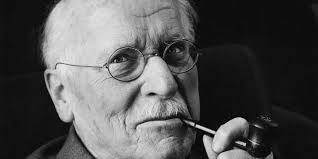From Wikipedia, the free encyclopedia

The anima and animus are described in Carl Jung’s school of analytical psychology as part of his theory of the collective unconscious. Jung described the animus as the unconscious masculine side of a woman, and the anima as the unconscious feminine side of a man, each transcending the personal psyche. Jung’s theory states that the anima and animus are the two primary anthropomorphic archetypes of the unconscious mind, as opposed to the theriomorphic and inferior function of the shadow archetypes. He believed they are the abstract symbol sets that formulate the archetype of the Self.
In Jung’s theory, the anima makes up the totality of the unconscious feminine psychological qualities that a man possesses and the animus the masculine ones possessed by a woman. He did not believe they were an aggregate of father or mother, brothers, sisters, aunts, uncles, or teachers, though these aspects of the personal unconscious can influence a person’s anima or animus.
Jung said that “the encounter with the shadow is the ‘apprentice-piece’ in the individual’s development … that with the anima is the ‘masterpiece'”.
–Jung quoted in Anthony Stevens On Jung (London 1990) p. 206
Jung believed a male’s sensitivity is often lesser or repressed, and therefore considered the anima one of the most significant autonomous complexes. Jung believed the anima and animus manifest themselves by appearing in dreams and influence a person’s attitudes and interactions with the opposite sex. A natural understanding of another member of the opposite sex is instilled in individuals that stems from constant subjection to members of the opposite sex. This instilment leads to the development of the anima and animus.[1] Jung said that “the encounter with the shadow is the ‘apprentice-piece’ in the individual’s development … that with the anima is the ‘masterpiece'”.[2] Jung viewed the anima process as being one of the sources of creative ability. In his book The Invisible Partners, John A. Sanford said that the key to controlling one’s anima/animus is to recognize it when it manifests and exercise our ability to discern the anima/animus from reality.[3]
More at: https://en.wikipedia.org/wiki/Anima_and_animus#cite_note-2
Anima mundi
From Wikipedia, the free encyclopedia
The world soul (Greek: ψυχὴ κόσμου psychè kósmou; Latin: anima mundi) is, according to several systems of thought, an intrinsic connection between all living things on the planet, which relates to the world in much the same way as the soul is connected to the human body. Plato adhered to this idea and it was an important component of most Neoplatonic systems:
Therefore, we may consequently state that: this world is indeed a living being endowed with a soul and intelligence … a single visible living entity containing all other living entities, which by their nature are all related.[1]
The Stoics believed it to be the only vital force in the universe. Similar concepts also hold in systems of eastern philosophy in the Brahman–Atman of Hinduism, the Buddha-Nature in Mahayana Buddhism,[citation needed] and in the School of Yin-Yang, Taoism, and Neo-Confucianism as qi.
Other resemblances can be found in the thoughts of hermetic philosophers like Paracelsus, and by Baruch Spinoza, Gottfried Leibniz, Immanuel Kant, Friedrich Schelling and in Hegel‘s Geist (“Spirit”/”Mind”).
In Jewish mysticism, a parallel concept is that of “Chokhmah Ila’ah,” the all-encompassing “Supernal Wisdom” that transcends, orders and vitalizes all of creation. Rabbi Nachman of Breslov states that this sublime wisdom may be apprehended (or perhaps “channeled”) by a perfect tzaddik (holy man).[2] Thus, the tzaddik attains “cosmic consciousness” and thus is empowered to mitigate all division and conflict within creation.
